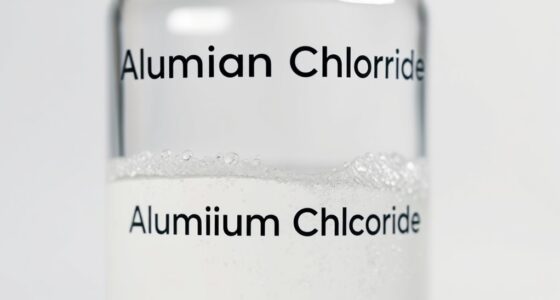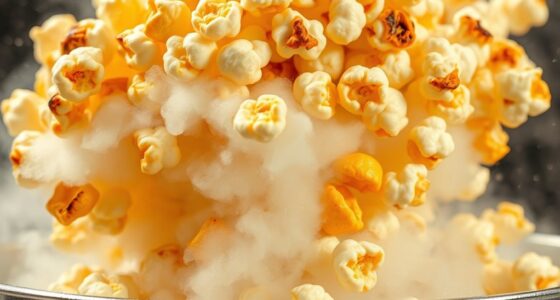Heat, salt, and acids are key to transforming food by triggering chemical reactions and structural changes. Heat causes proteins to denature, starches to gelatinize, and initiates Maillard browning and caramelization, creating flavor, color, and texture. Salt enhances flavor and preserves, while acids lower pH and denature proteins, improving safety and texture. Together, these elements shape how raw ingredients become delicious, fragrant, and appealing — if you want to explore how these processes work, keep going.
Key Takeaways
- Heat triggers chemical reactions like caramelization and Maillard browning, developing flavor, color, and texture in foods.
- Salt enhances taste, preserves, and influences texture by reducing water activity and activating flavor receptors.
- Acids denature proteins, lower pH, inhibit bacteria, and add brightness, improving safety and texture.
- Heat causes proteins to denature and starches to gelatinize, transforming raw ingredients into tender, flavorful dishes.
- Emulsifiers stabilize mixtures of oil and water, improving food texture and consistency during cooking.
How Heat Alters Food Structures and Flavors

When you apply heat to food, it triggers a series of chemical and physical changes that transform its structure and flavor. Proteins coagulate, making foods like eggs firmer, while starches gelatinize, absorbing moisture and softening, which is why pasta and rice become larger and smoother. Fats melt, altering the texture and mouthfeel of items like butter or meat. Cell walls in vegetables break down, resulting in tender textures. Heat also denatures structures, which can interact with other chemicals to develop new flavors. These changes influence the overall taste, aroma, and mouthfeel of your food. Heat causes chemical reactions like caramelization and the Maillard reaction, further enhancing flavors. For example, thermal processing can influence nutrient retention and the development of complex flavors. By understanding how heat affects these components, you can better control cooking processes to achieve desired textures and flavors, making your dishes more enjoyable and well-balanced.
The Maillard Reaction: Creating Complex Aromas and Colors
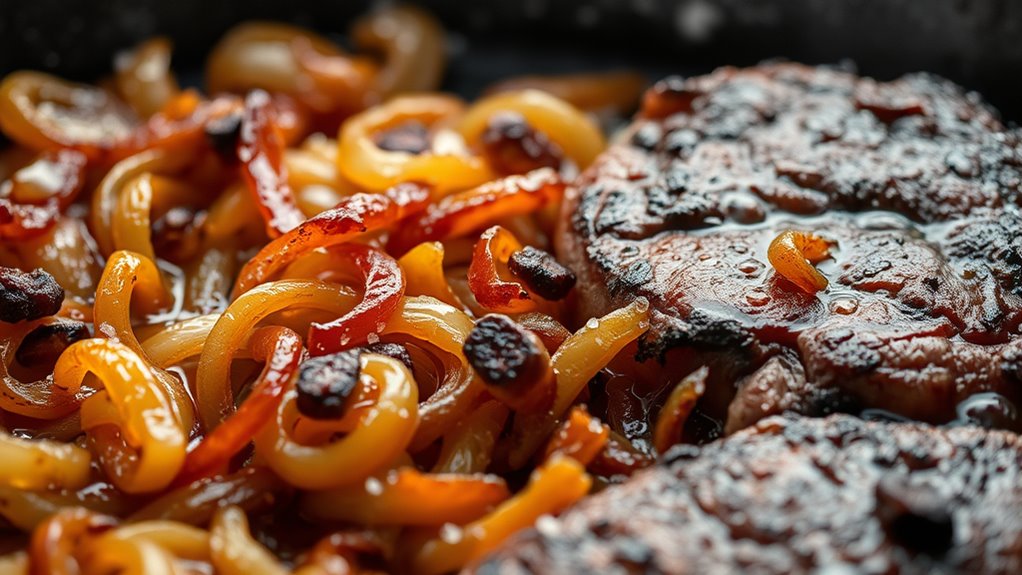
The Maillard reaction occurs when amino acids and reducing sugars are heated together, leading to a series of complex chemical transformations. It begins above 140°C, with heat speeding up the reaction and causing water to evaporate, which concentrates reactants. Multiple small reactions happen simultaneously, forming molecules responsible for flavor, aroma, and browning. Reactive intermediates like methylglyoxal, glyoxal, and furfural derivatives drive the process. Over time, large brown polymers called melanoidins develop, giving food its appealing color and texture. This reaction produces hundreds of flavor and aroma compounds, creating roasted, nutty, and complex profiles. Understanding these chemical processes can help chefs optimize cooking techniques for better taste and appearance. Additionally, controlling temperature and pH allows for precise manipulation of these reactions, tailoring the final flavor and color to desired outcomes.
Protein Denaturation and Its Role in Texture and Digestion
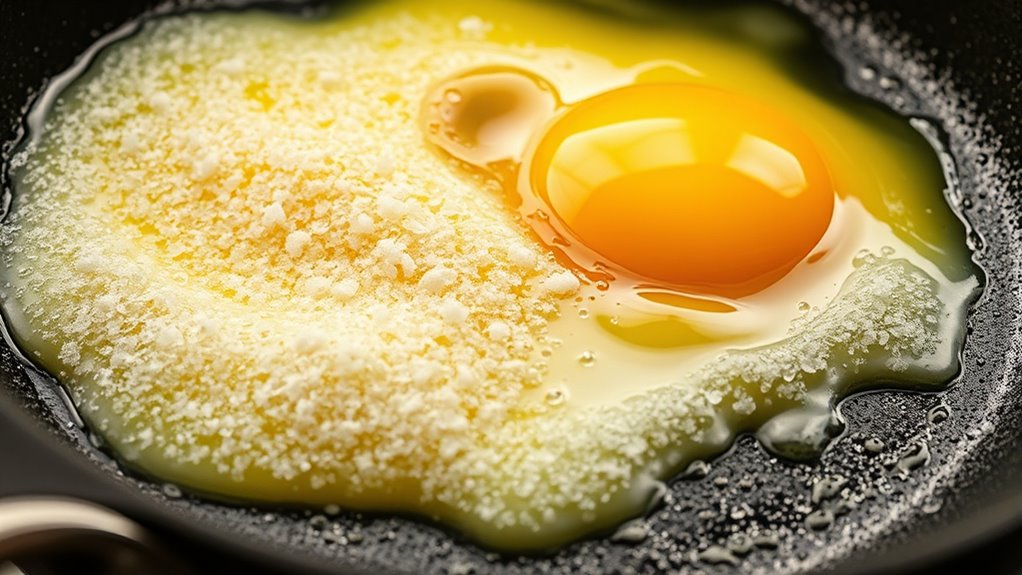
Heating and other cooking processes cause proteins to undergo denaturation, fundamentally changing their structure. When you heat food, proteins vibrate more intensely, breaking weak bonds and unfolding into new shapes. Acid, high salt, alcohol, and mechanical agitation can also cause denaturation by disrupting electrostatic and hydrophobic interactions. This structural change makes proteins more accessible to digestive enzymes, improving digestion and nutrient absorption. Denatured proteins are often less allergenic and can enhance bioavailability. In food, denaturation impacts texture—creating tender, juicy meat or firmer baked goods—by forming protein aggregates and networks. For example, cooked eggs firm up as proteins unfold and re-bond, while meat becomes more digestible. Overall, denaturation plays a pivotal role in transforming raw ingredients into safe, flavorful, and nutritious dishes. Additionally, the process of denaturation can be influenced by pH levels, which are crucial in determining the extent and nature of protein structural changes during cooking.
Different Cooking Techniques and Their Heat Applications
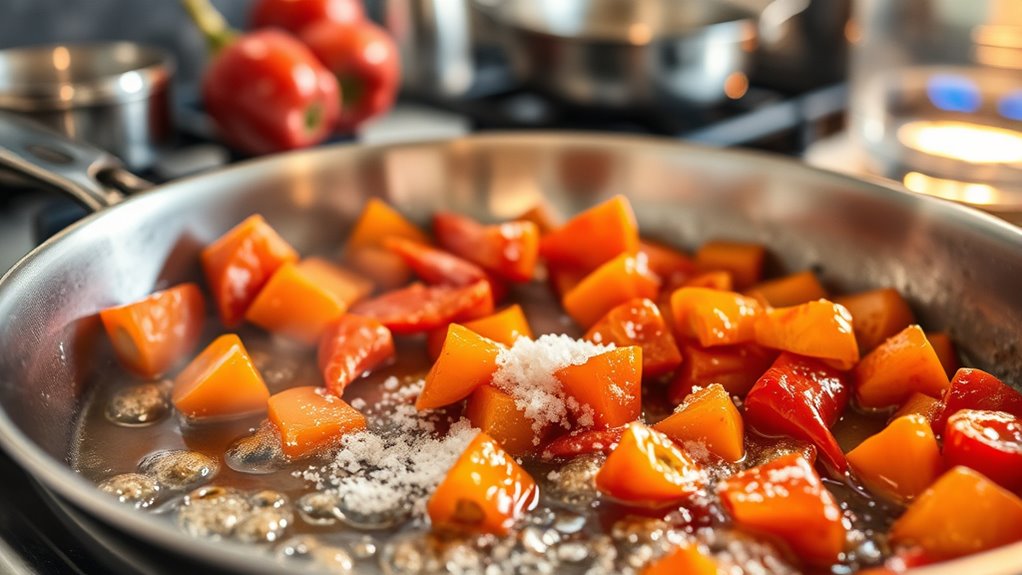
Different cooking techniques apply heat in various ways to achieve specific textures and flavors. High-heat methods like grilling and broiling quickly sear food, creating browning through the Maillard reaction, while low-heat techniques such as baking and simmering develop deeper flavors and tender textures. Moisture-based methods like steaming and poaching use water or broth to gently cook foods without drying them out. Convection ovens circulate hot air for even cooking, whereas radiation methods like infrared and microwaves transfer heat directly to food surfaces. Conduction, as in pan frying, transfers heat directly through contact. Some techniques combine these methods, like braising, which uses moist heat at low temperatures for tender results. Understanding how these techniques apply different heat transfer modes helps you control texture and flavor precisely. Additionally, knowing the specific applications of these methods can help optimize tiny house designs for efficient cooking and energy use in small living spaces.
The Role of Salt in Flavor Enhancement and Preservation
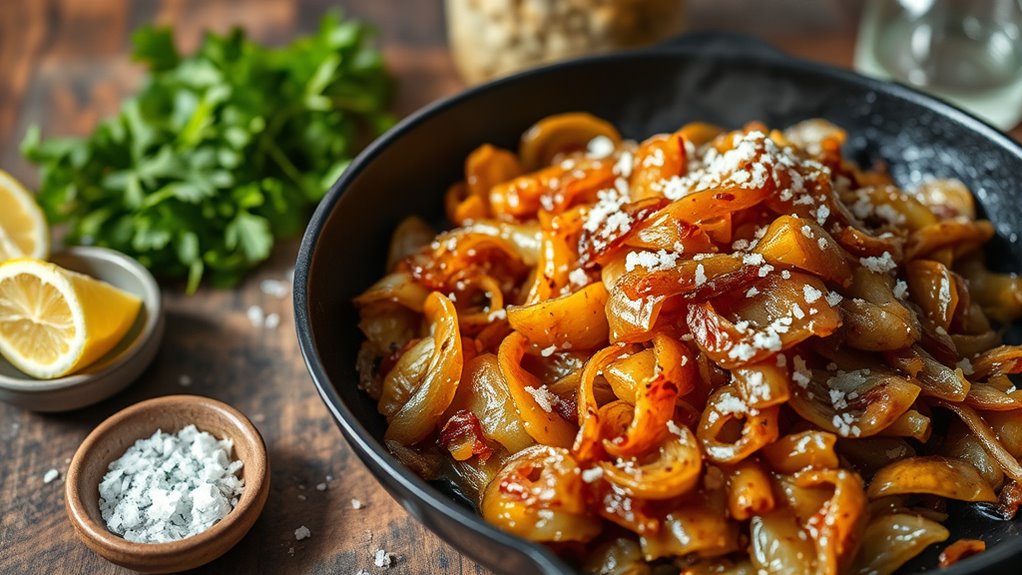
Salt plays a crucial role in enhancing the flavor of your food by balancing and amplifying other tastes. It doesn’t just add a salty note but boosts sweetness, minimizes bitterness, and heightens aroma, making flavors more vivid. Salt activates taste receptors, increasing overall flavor perception and appetite. In preservation, salt reduces water activity, creating an environment hostile to spoilage microbes, which extends shelf life, especially in meats and pickles. It also helps prevent chemical changes like oxidation and browning, maintaining food quality. During fermentation, salt encourages beneficial bacteria growth while inhibiting harmful microbes, producing distinctive textures and flavors in products like sauerkraut and cured meats. Additionally, salt influences food texture by modifying proteins and drawing moisture, enhancing juiciness, tenderness, and overall mouthfeel.
How Acids Balance and Brighten Culinary Profiles
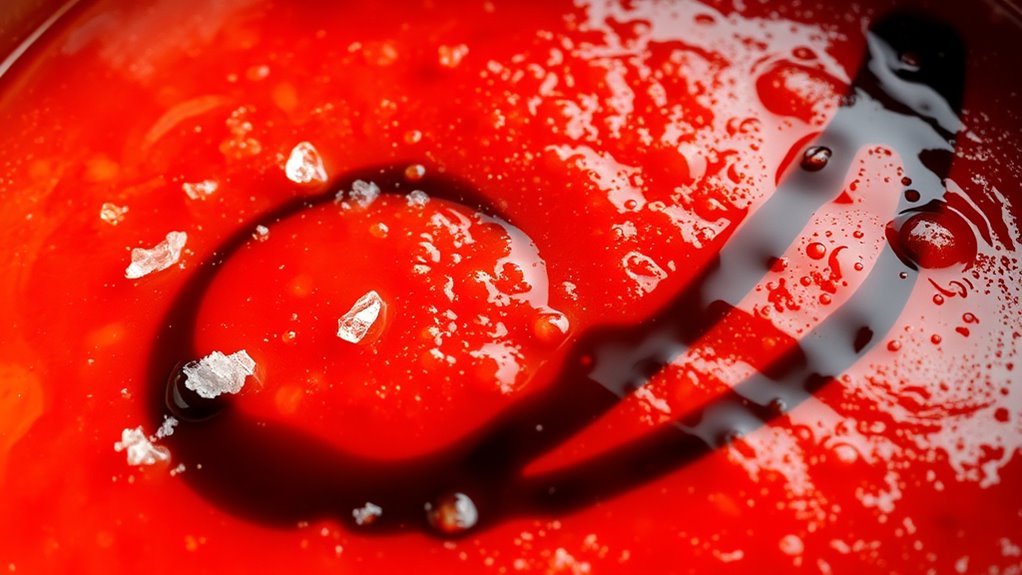
Acids play a pivotal role in shaping the overall flavor profile of your dishes by adding brightness and balance. They introduce tangy, sharp, or sour notes that counteract sweetness, saltiness, and richness, preventing your food from feeling heavy. Acids also stimulate saliva, making flavors more perceptible and invigorating. By adjusting acidity levels through reductions or deglazing, you fine-tune your dish’s harmony. They brighten flavors, enhancing freshness and making ingredients like fruits and vegetables taste more vibrant. Different acids, such as citrus juice or vinegar, bring unique character—bright and sharp or pungent and pungent—affecting the dish’s overall tone. Proper use of acids ensures a balanced, lively flavor profile that elevates your culinary creations. Additionally, understanding the impact of flavor balance can help you create more harmonious and appealing dishes.
Synergistic Effects of Salt, Acid, and Fat in Cooking

The combined use of salt, acid, and fat creates powerful flavor amplification and texture effects that elevate your dishes beyond their individual components. Salt enhances aroma perception by increasing the volatility of flavor compounds, making dishes smell more enticing. Fat acts as a flavor solvent, dissolving and carrying fat-soluble molecules to your palate. Acid balances richness by counteracting the fatty mouthfeel, providing a revitalizing contrast. Together, these elements create layered taste profiles that are more complex and satisfying. Strategically adding salt during cooking and acid before serving maximizes their synergy. This trio also influences texture: salt retains moisture, fat inhibits gluten development, and acid tenderizes proteins. Their interplay results in more flavorful, balanced, and appealing dishes. Regularly assessing and adjusting ingredient levels can further enhance their culinary effectiveness to achieve optimal taste and texture.
Chemical Reactions Behind Caramelization and Gelatinization

Caramelization and gelatinization are fundamental chemical processes that transform raw ingredients into flavorful and textured dishes. During caramelization, heating sugars causes molecular breakdown and recombination reactions. Sucrose splits into glucose and fructose, then loses water through dehydration, creating smaller compounds that develop aroma and flavor. Polymerization forms large brown polymers, giving caramel its color and texture. These reactions produce volatile compounds like diacetyl, adding buttery and caramel notes. Conversely, gelatinization involves starch granules absorbing water and swelling when heated between 60-80°C. This physical change disrupts crystalline structures, thickening mixtures and forming gels. As starch molecules leach out, the mixture’s viscosity increases, creating smooth textures in foods like sauces and custards. Both processes are essential for developing flavor, color, and texture in cooking. Understanding heat transfer is crucial for controlling these reactions and achieving desired culinary results.
Emulsification and Stabilization of Flavors and Textures
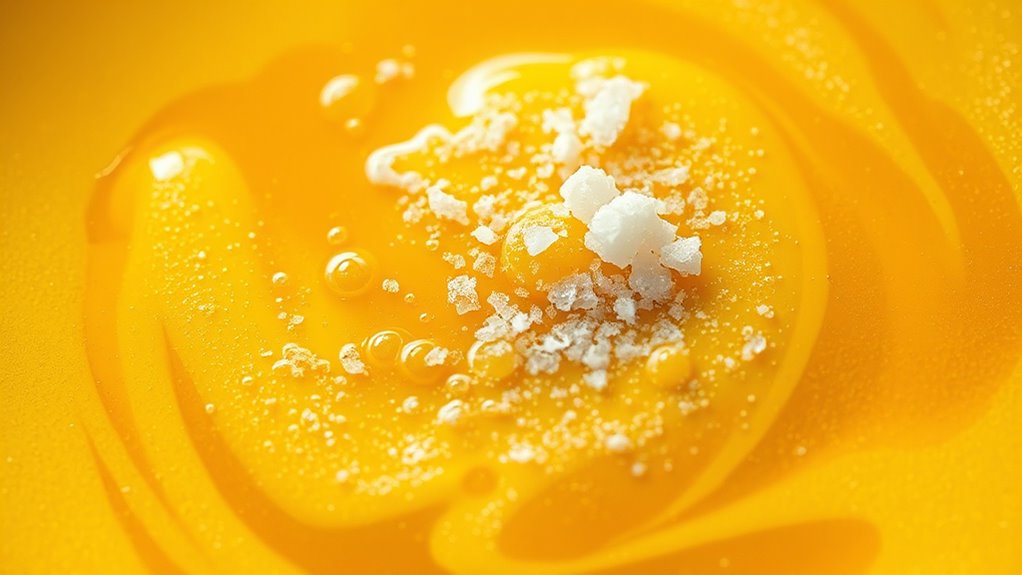
Emulsification is a fundamental technique in cooking that allows you to combine oil and water-based ingredients into a stable, homogeneous mixture. You achieve this by mechanically agitating the liquids, dispersing tiny droplets of one into the other to increase surface contact. Without emulsifiers, these mixtures separate quickly because oil and water naturally repel each other. Emulsifiers, like lecithin or mustard, are amphiphilic molecules that adsorb at the oil-water interface, reducing interfacial tension and forming a protective barrier around droplets. This stabilization prevents coalescence, maintaining a consistent texture and flavor. Emulsions are essential in sauces, dressings, and spreads, where proper stabilization ensures a rich, smooth mouthfeel. Factors like emulsifier type, concentration, and mixing technique influence the stability and quality of your emulsion. Additionally, understanding the role of stabilizers in emulsification can help improve the longevity and consistency of your culinary creations.
Nutritional and Safety Implications of Heating, Salting, and Acidifying

Cooking techniques that involve heating, salting, and acidifying foods considerably influence both their nutritional content and safety. Heating can cause nutrient loss, especially water-soluble vitamins like C and B-complex, with prolonged or high-temperature cooking accelerating this process. Steaming preserves these vitamins better than boiling, while pressure or slow cooking can improve nutrient bioavailability but also lead to leaching into cooking liquids. Proper cooking kills harmful bacteria, ensuring safety, but overcooking can produce harmful compounds like acrylamide. Salt enhances flavor and acts as a preservative by reducing water activity, but excessive intake raises health risks. Acids improve texture and safety by denaturing proteins and lowering pH, which inhibits bacteria. Balancing heat, salt, and acid use optimizes nutrition, flavor, and food safety.
Frequently Asked Questions
How Does Temperature Influence Nutrient Retention During Cooking?
You might wonder how temperature affects nutrient retention during cooking. When you cook at lower temperatures and for shorter times, you preserve more heat-sensitive nutrients like Vitamin C and B-vitamins. Higher temperatures, especially above 140°F, cause more nutrient loss, particularly water-soluble vitamins. Using gentle methods like steaming or microwaving helps retain nutrients better than boiling. Overall, controlling temperature and cooking duration is key to maximizing nutrient preservation.
Can the Type of Salt Change the Nutritional Value of Food?
Think of salt as the silent conductor of your kitchen symphony. The type of salt you choose doesn’t substantially change the food’s nutritional value since most salts, whether table or Himalayan pink, mainly provide sodium. While some contain trace minerals or iodine, these are minimal and don’t impact your diet greatly. Your focus should be on moderating sodium intake and choosing salts that suit your taste and dietary needs.
How Do Different Acids Affect the Shelf Life of Preserved Foods?
You might wonder how different acids influence preserved foods‘ shelf life. Acetic acid, used in pickling, creates a low pH that inhibits bacteria, extending shelf life to 12-18 months. Lactic acid offers similar benefits in sauces, while citric acid helps maintain color and nutritional content in fruits. The type and concentration of acid determine microbial stability, food safety, and how long your preserved foods stay good, especially when combined with proper processing methods.
What Is the Impact of Heat on Water-Soluble Vitamins?
Heat critically impacts water-soluble vitamins, especially vitamin C and B vitamins. When you cook, these nutrients degrade quickly, with boiling causing the most loss—up to 50% or more for vitamin C. To preserve them, use gentler methods like steaming, avoid prolonged cooking, and consume cooking liquids. Cooking at lower temperatures and adding acids can also help retain these essential nutrients, keeping your food more nutritious.
Are There Safety Risks Associated With Improper Use of Salt and Acids?
You should be aware that improper use of salt and acids can pose safety risks. Handling salt without precautions may cause chemical exposure, and excessive salt intake can lead to health issues like high blood pressure. For acids, improper handling might cause burns or corrosive injuries. Using them together without proper knowledge can also trigger unwanted reactions. Always follow safety guidelines to prevent accidents, and use these ingredients responsibly in your cooking.
Conclusion
Understanding the chemistry behind cooking transforms everyday meals into culinary masterpieces. By mastering how heat, salt, and acids work together, you reveal flavors and textures that can turn simple ingredients into a symphony of taste. Think of your kitchen as a scientific arena where you hold the power to create magic—no recipe is too complex, and no dish is beyond your mastery. Embrace the science, and watch your cooking reach legendary status!


